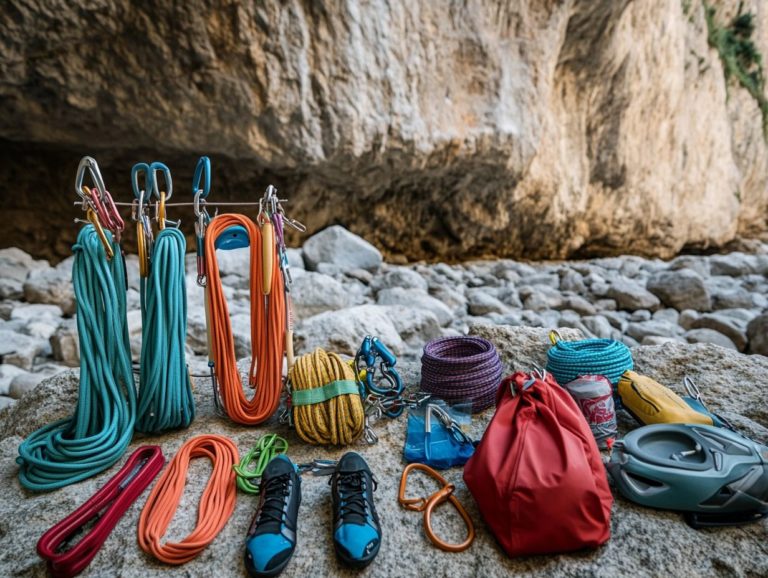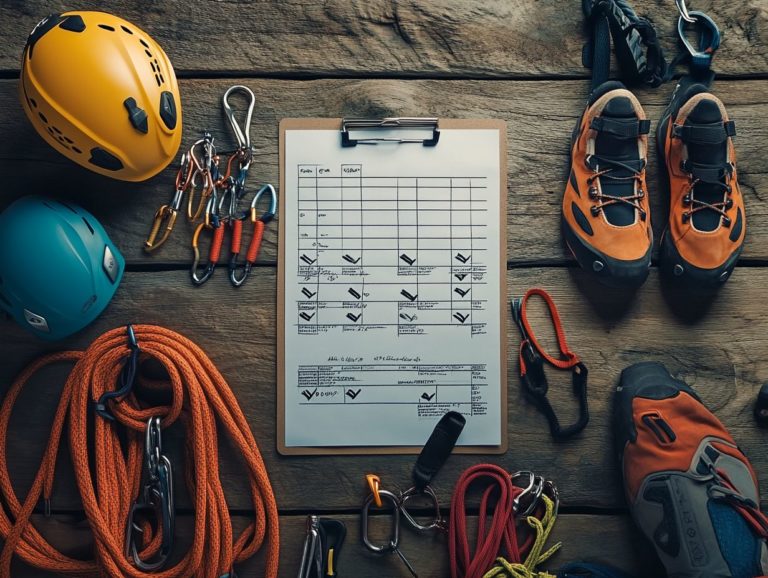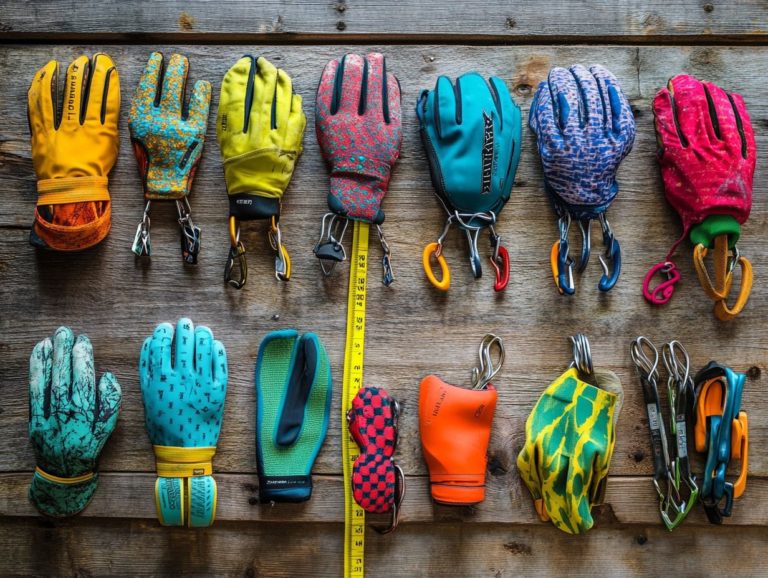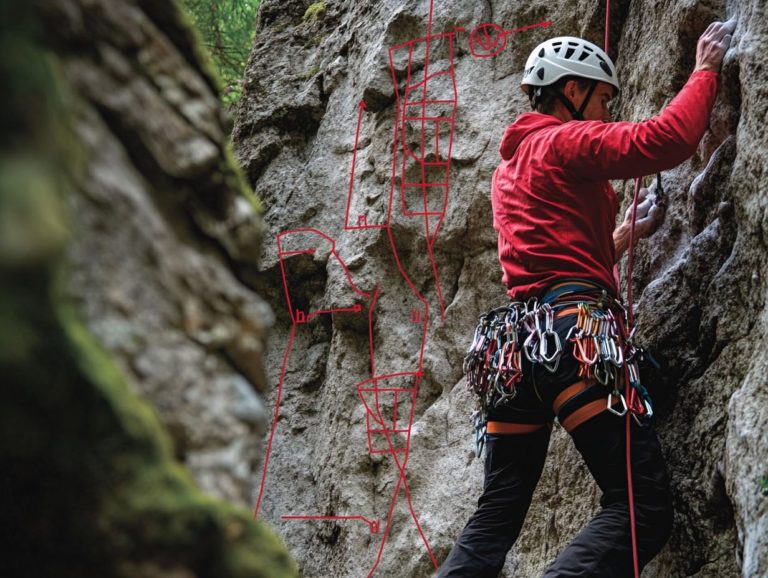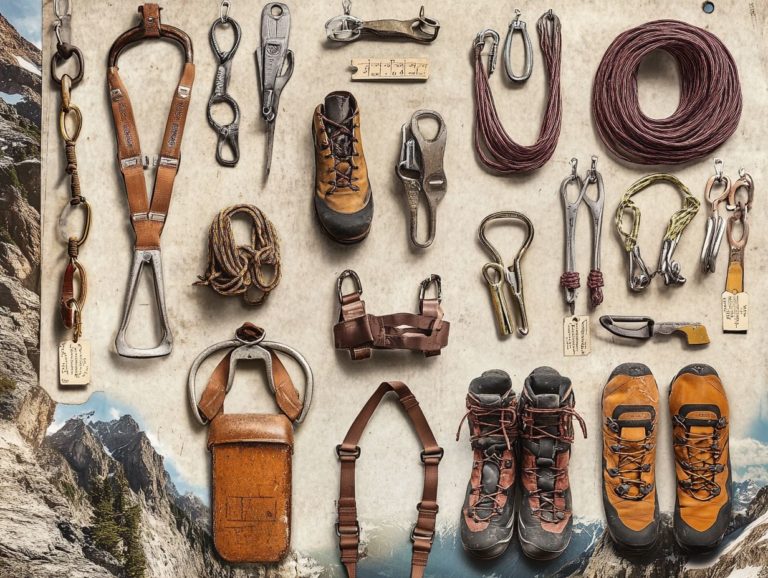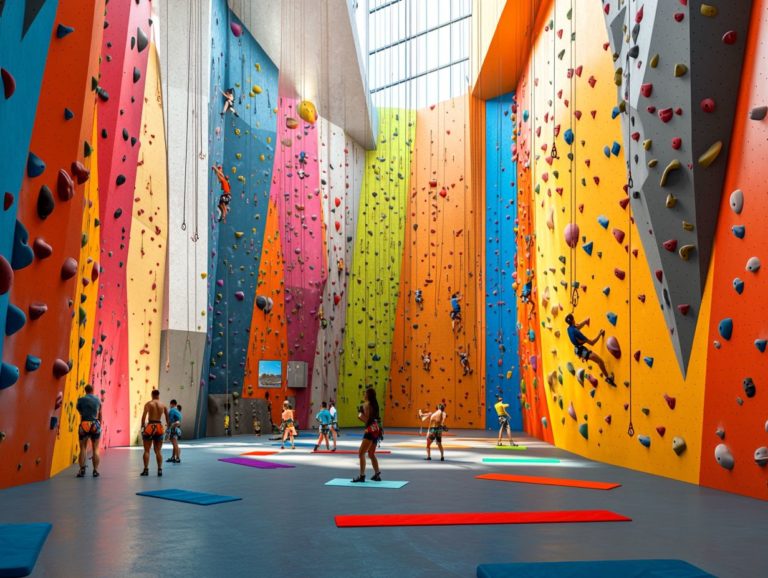How to Choose a Climbing Guidebook
Choosing the right climbing guidebook can truly improve your outdoor climbing adventures.
With the plethora of options available, grasping what a climbing guidebook encompasses, including insights on climbing techniques, is crucial.
This article will walk you through the essential factors to consider, from the climbing area and climbing type to the depth of detail and accuracy you should expect.
You ll also discover how to research and compare guidebooks effectively, allowing you to prioritize your unique needs and preferences.
By the end, you’ll be excited and ready to choose the perfect guidebook for your climbing journey.
Contents
Key Takeaways:
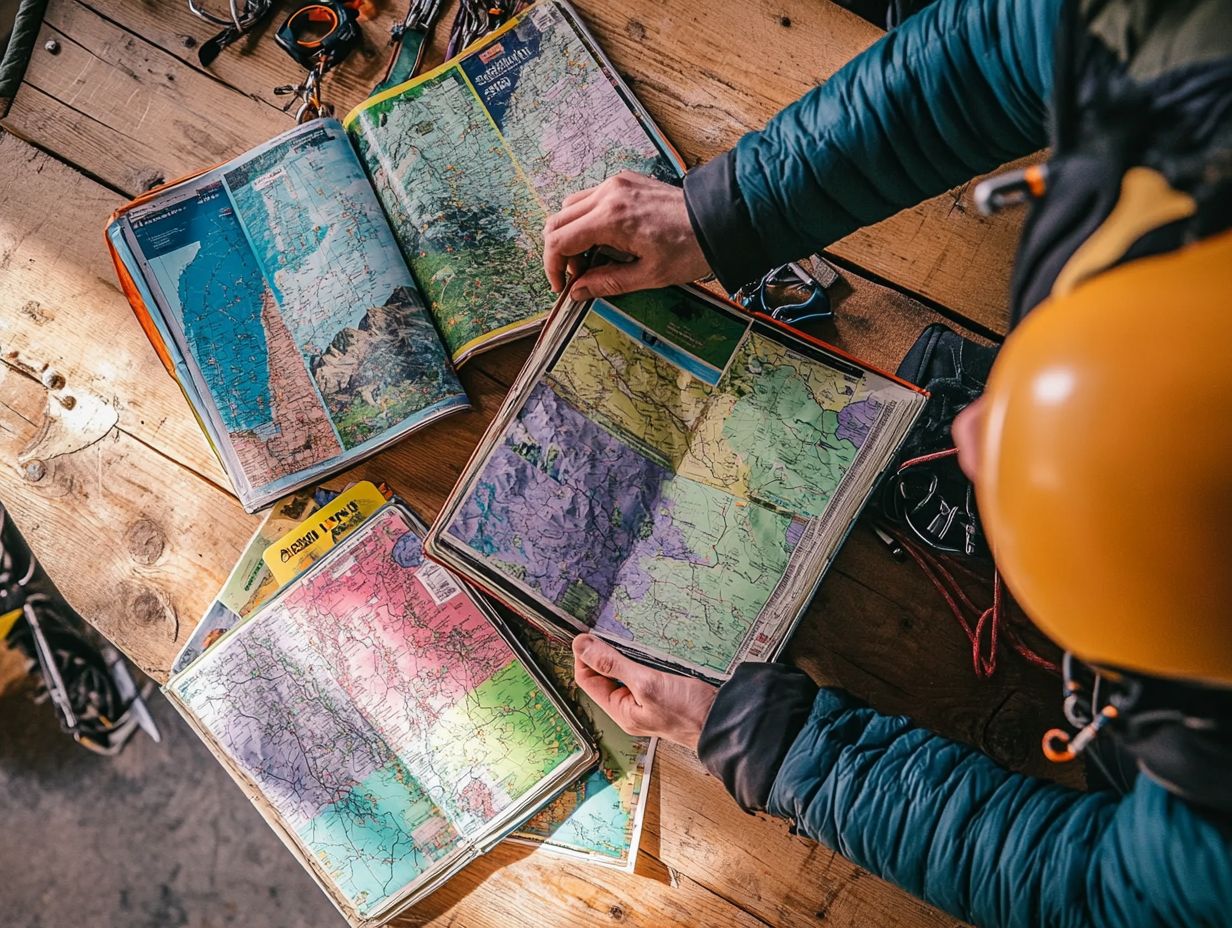
- Consider the location and type of climbing you will be doing when choosing a guidebook.
- Research and compare guidebooks by reading reviews and gathering recommendations from experienced climbers.
- Prioritize your climbing needs and preferences to make the final decision on the best guidebook for you.
Understanding Climbing Guidebooks
Understanding climbing guidebooks is crucial for anyone aiming to improve their climbing experience. These resources offer invaluable insights into diverse climbing areas, techniques, and challenges.
They act as a bridge between novice climbers and the rich tapestry of climbing history. Guidebooks provide meticulous route descriptions and critical safety information.
By diving into thoughtfully curated guidebooks, you can uncover premier climbing destinations and arm yourself with essential tips on routes, enabling you to make informed decisions for your climbing adventures.
What is a Climbing Guidebook?
A climbing guidebook is your ultimate resource, packed with essential information about climbing routes, climbing techniques, and the geographical features of various climbing areas.
These guidebooks don t just help you navigate; they also provide important information into the unique challenges each route may throw your way. You ll discover detailed route descriptions that include difficulty ratings, recommended climbing techniques, and even gear suggestions, ensuring you re thoroughly prepared for your adventures.
The inclusion of accurate tips the helpful tips about holds, cruxes, and potential hazards can significantly elevate your experience and enhance your safety on the rock face. Thoughtfully designed maps guide you to the best approaches, making your outdoor climbing experience both enriching and enjoyable.
Factors to Consider When Choosing a Guidebook
Selecting the perfect climbing guidebook entails several essential factors that can profoundly influence your climbing experiences and skill development. Consider the specific climbing areas you wish to explore, as well as the detailed intricacies of the climbing routes outlined within. These elements will help you customize your climbing journey to suit your individual preferences and goals.
A quality guidebook offers valuable insights into climbing techniques and safety measures, ensuring you are thoroughly equipped for your adventures. Don t overlook the importance of climbing reviews and community recommendations; they can greatly enhance your decision-making process.
Location and Type of Climbing

When you’re selecting a climbing guidebook, it’s essential to understand the specific climbing area and your preferred type of climbing, whether that’s sport or traditional. This understanding is crucial for ensuring a successful and enjoyable climbing experience.
Choosing a guidebook that aligns with these criteria can profoundly impact your performance and overall enjoyment. Take iconic destinations like Yosemite or Joshua Tree, for example; each offers unique climbing environments. The information provided in the guidebooks should accurately reflect local conditions, routes, and safety measures that are tailored to the light rock faces or craggy overhangs you ll encounter.
Moreover, the nuances of local climate, rock quality, and seasonal changes underscore the importance of making the right choice. You should also consider how much emphasis a guidebook places on your preferred climbing style, whether it be climbing short, steep rocks without ropes or climbing multiple sections of rock with ropes. The subtle details in these areas can significantly elevate your overall adventure.
Level of Detail and Accuracy
The level of detail and accuracy in a climbing guidebook is crucial, as it directly shapes your understanding of climbing routes, safety protocols, and access maps.
With comprehensive climbing instructions and well-illustrated route diagrams at your fingertips, you can effectively plan your ascents. This ensures you re prepared for the various challenges that may arise on your journey.
Having precise and up-to-date information enhances not just your overall climbing experience but is vital for your safety as well.
When you re aware of current conditions, potential hazards, and exit strategies, you re better equipped to make informed decisions about your route. Knowing current conditions can dramatically lower your chances of accidents, putting you in control of your climb!
As you navigate the complexities of nature, this invaluable resource serves as your guide, striking the perfect balance between adventure and caution.
Additional Features and Resources
Additional features and resources in climbing guidebooks, like climbing tools (equipment that helps you ascend safely), climbing certifications (which ensure you know how to climb safely and handle risks), and community reviews, can significantly enhance your experience and preparation as a climber.
By providing insightful reviews from fellow climbers, these resources foster a sense of camaraderie and shared wisdom within the climbing community. You have the opportunity to learn from the experiences of others, enabling you to make informed decisions about routes, gear, and techniques.
Recommendations for training programs and safety certifications are essential. They equip you with the knowledge needed to improve your skills and ensure your safety while navigating challenging terrains.
Ultimately, these supplementary resources enable you to engage more deeply with the sport, cultivating both climbing competence and confidence as you progress on your climbing journey.
Researching and Comparing Guidebooks
Researching and comparing climbing guidebooks is an essential step in choosing the ideal resource for your climbing adventure. This ensures you have access to the most pertinent climbing tools and techniques.
By immersing yourself in climbing community feedback and expert reviews, you can assess the strengths and weaknesses of various guidebooks. This helps you customize your selection to suit your specific climbing needs.
Reading Reviews and Gathering Recommendations
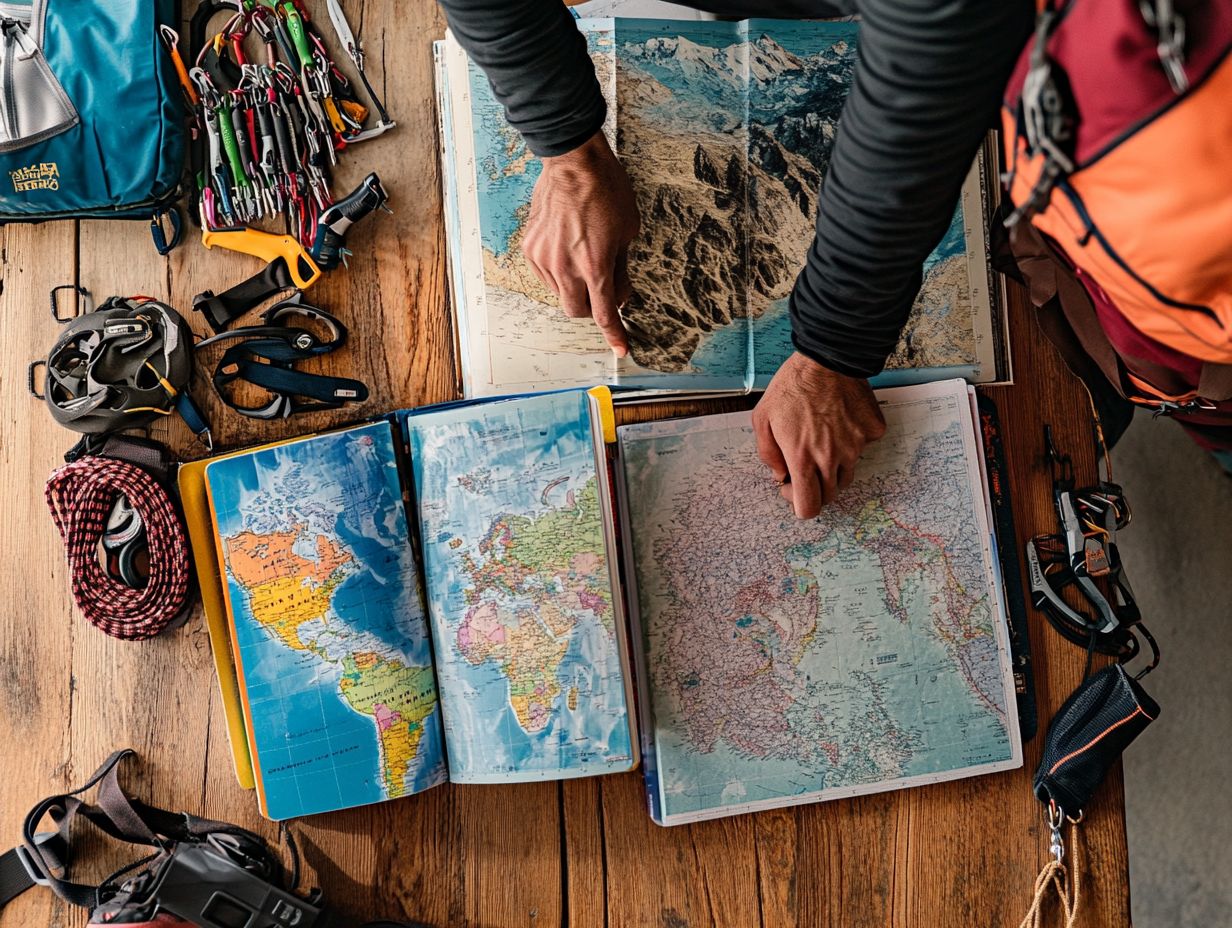
Reading reviews and gathering recommendations from the climbing community offers you invaluable insights into the usefulness and reliability of various climbing guidebooks.
By tapping into the collective experiences of fellow climbers, you can uncover crucial details that might be overlooked in the official material. Joining online forums or social media groups allows you to connect with others and get their insights, providing genuine, firsthand accounts of different routes and techniques.
These perspectives often shed light on important nuances such as weather conditions, climbing gear suggestions, and climbing safety concerns that can significantly impact both your planning and enjoyment.
Ultimately, embracing a diverse range of opinions and stories enriches your understanding of potential climbing adventures, enabling you to make informed choices that align perfectly with your skill level and aspirations.
Choosing the Right Guidebook for You
Selecting the right climbing guidebook is a deeply personal choice that significantly influences your climbing education, skill development, and overall adventure. It s crucial to consider your unique needs, preferences, and climbing objectives when choosing a guidebook that will aid in your planning and enrich your experiences.
By thoughtfully evaluating your options and seeking out top-notch climbing recommendations, you can make a well-informed decision that resonates with your aspirations as a climber.
Start your climb today by choosing the perfect guidebook tailored just for you!
Prioritizing Your Needs and Preferences
Choosing a climbing guidebook is essential. It enhances your climbing skills and experiences.
Selecting the right guidebook is a thoughtful process that considers your unique climbing style, objectives, and methods. For instance, if you enjoy climbing on short, steep rocks, you might seek a guide that emphasizes powerful techniques and mental resilience. On the other hand, if sport climbing which involves climbing on routes that use fixed anchors for protection is your focus, you may want one that provides detailed routes and safety advice.
Your preferences matter. The right guide should inspire you to push your limits and explore new terrains. By aligning your choice with your aspirations and methods, you can maximize your potential and elevate your overall climbing experience.
Making the Final Decision
Choosing the perfect climbing guidebook can be thrilling but challenging. It shapes your climbing journey and future goals.
Evaluate your climbing interests and skill level. The ideal guidebook offers insights into local conditions and essential safety precautions.
When selecting a guidebook, consider the types of climbs you enjoy and the geographical areas you wish to explore. An ideal guide goes beyond just listing routes; it should also provide information on potential climbing competitions and challenges you may face.
For climbers facing unique challenges, the right guidebook becomes an invaluable ally. It offers tips and firsthand experiences that deepen your understanding and preparation. A good guide can make your climbing adventures even better, whether you’re planning a trip to Yosemite, Patagonia, or The Red River Gorge.
Frequently Asked Questions

1. What is a climbing guidebook?
A climbing guidebook is a resource that details climbing routes and safety measures for specific locations. It helps both beginners and experienced climbers navigate their climbs.
2. How do I choose the right climbing guidebook?
Choose a guidebook based on your climbing level and preferred location. Recommendations from climbers or local shops can guide you.
3. Should I choose a print or digital guidebook?
Decide between print and digital based on your needs. Print guides offer easy reference, while digital ones can be more current and interactive, including access maps for various climbing areas.
4. What should I look for in a climbing guidebook?
Look for detailed route descriptions and potential hazards in a guidebook. It should include maps and photos to help you navigate and enrich your climbing experiences. Bonus features like historical and cultural insights can further enhance your journey.
5. Can I use multiple guidebooks for one climbing trip?
Yes, you can use multiple guidebooks for a climbing trip. Different guidebooks may focus on various aspects, like climbing techniques or specific routes.
Since the details and coverage can vary, cross-referencing multiple sources can give you a better understanding of the area. This approach helps you gather comprehensive insights and tips.
6. Are there alternatives to traditional climbing guidebooks?
Yes, alternatives exist! Online forums and apps offer valuable information and tips on routes and competitions.
These resources provide real-time updates and user-generated insights. However, they may lack the depth and accuracy of well-known guidebooks.
To plan your climb effectively, tap into both guidebooks and online resources. Combining these can enhance your experience!

